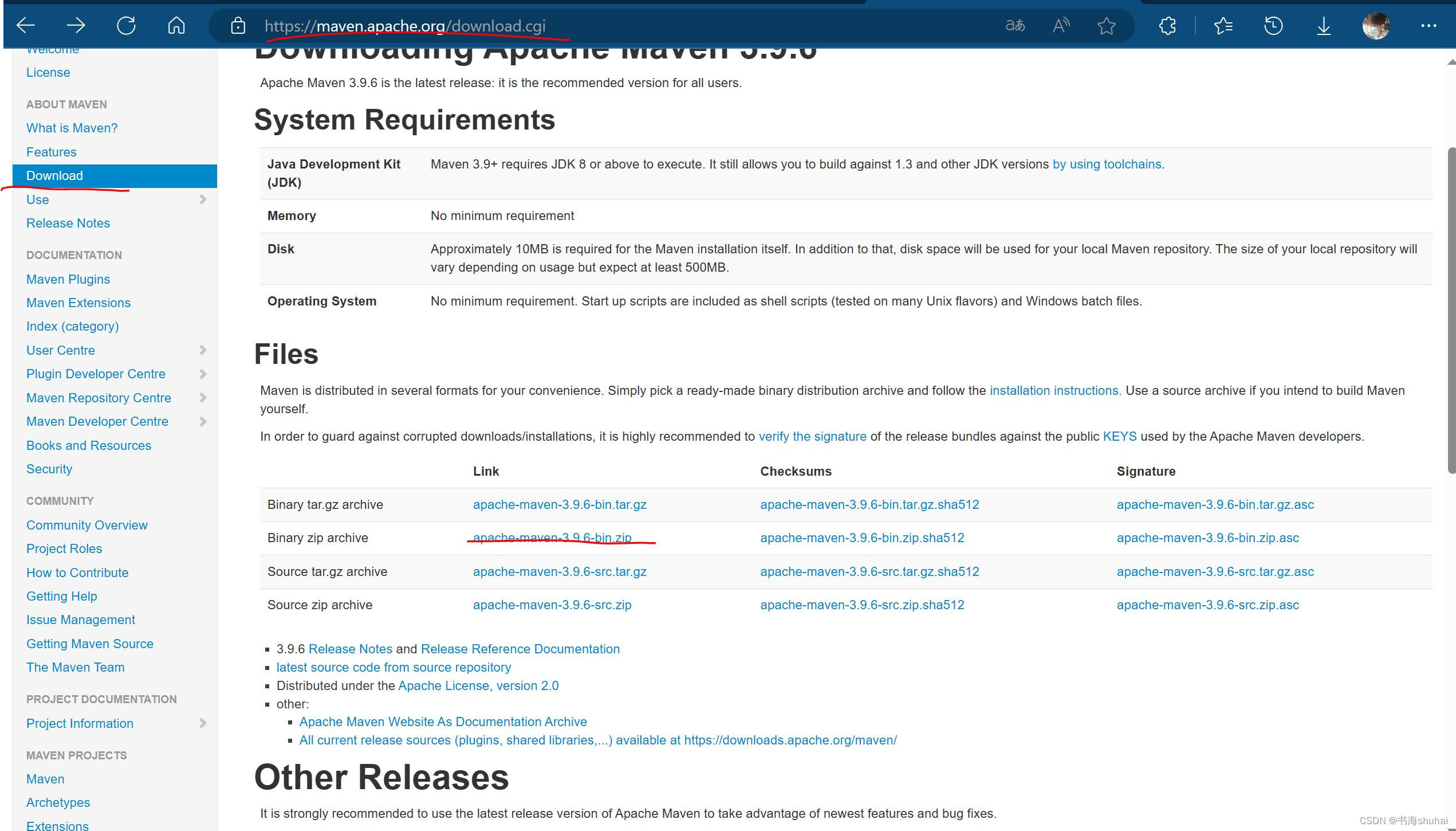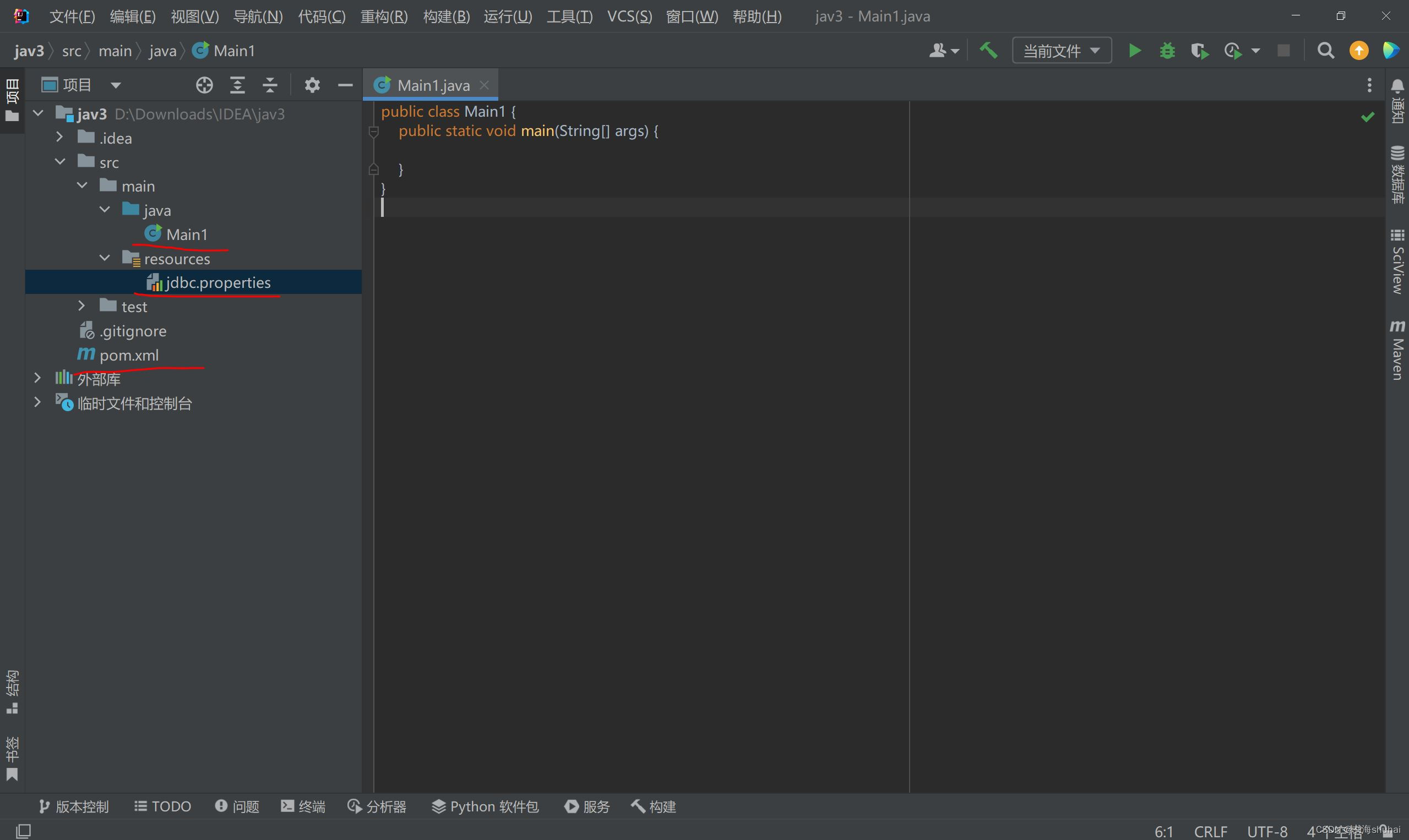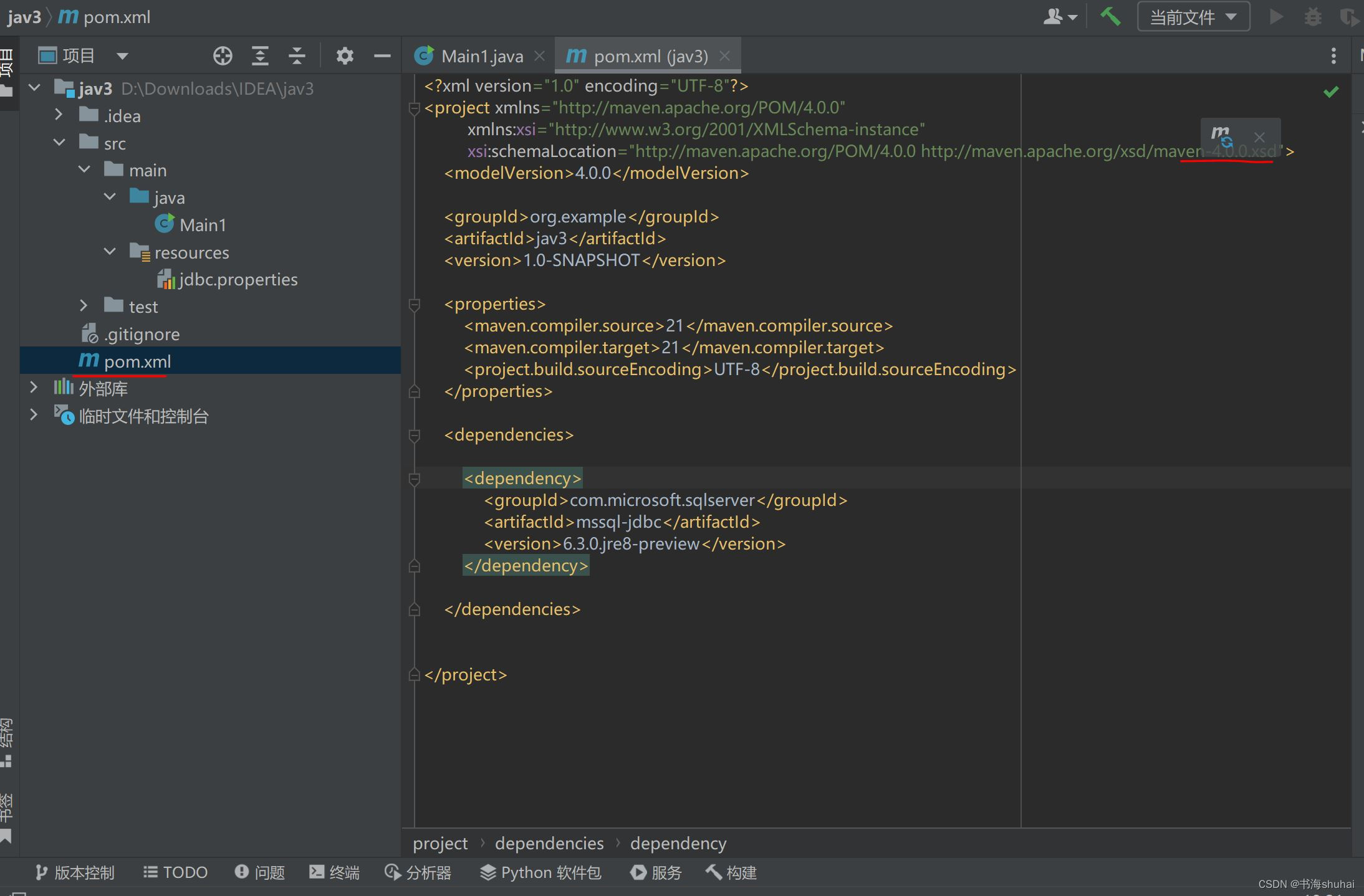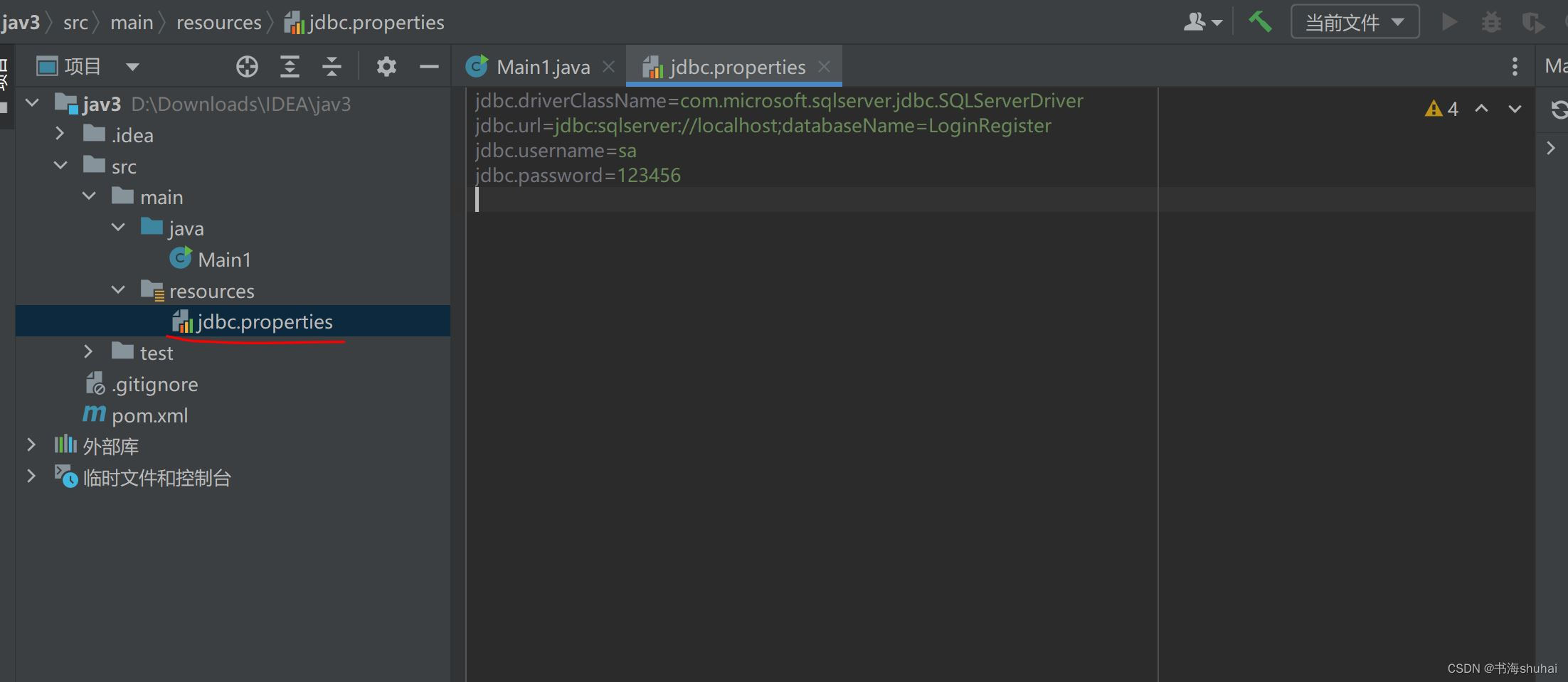Intellij IDEA创建Java项目,连接SQL Server数据库项目,实现账号登录注册等基础功能。【入门学习】
目录
- 一、创建SQL数据库文件
- 二、下载和配置Maven文件
- 三、编写Java项目源代码
- 四、编写源代码文件
- 五、结语
今天为大家带来一个简单的JAVA项目,连接SQL Server数据库实现账号登录等功能,SQL Server2022,Intellij IDEA2023,java版本openjdk-21,maven版本3.9.6。
我得说明一下,你直接运行这个源代码是没有用的!一步一步配置好环境来,再去运行。
当然了,这个主要适合新人基础入门学习,话不多说,直接开始。
一、创建SQL数据库文件
1. 打开SQL数据库,记住服务器名称、登录名和密码这些信息:
2. 创建一个“LoginRegister”数据库,在里面新建一张“账号登录”表。这个数据库和表的名字可以自定义,但是后面的代码里面相关信息也要对应修改,所以,熟悉后,再去修改,自己尝试一下。
二、下载和配置Maven文件
1. 可以去maven官网下载,自定义选择自己需要的版本,下面我以3.9.6版本进行演示。
https://maven.apache.org/download.cgi
https://archive.apache.org/dist/maven/maven-3/
2. 下载后解压在指定位置,不要乱移动!在里面新建一个Repository仓库文件夹。
3. 通过IDEA打开conf里面的settings.xml文件进行编辑。
在这个位置添加下面这行代码。这个仓库位置一定是自己创建的仓库所在路径,看清楚!
D:\Downloads\IDEA\apache-maven-3.9.6\Repository
5. 然后往下滑,在这个位置添加下面这行代码,配置阿里云镜像文件:
alimaven aliyun maven https://maven.aliyun.com/nexus/content/groups/public/ central6. 然后在IDEA设置里面配置Maven文件和路径:
三、编写Java项目源代码
1. 新建一个java项目,如图所示:
2. 如图所示进行创建文件,另外,不要忘记上面配置的maven设置。
3. 下载SQL数据库驱动文件,在pom.xml文件里面添加下面这行代码:
com.microsoft.sqlserver mssql-jdbc 6.3.0.jre8-preview添加代码后,点击右上方的刷新进行下载。如图所示:
4. 在jdbc.properties文件里面配置SQL数据库连接信息,添加下面这段代码:
这里我没有直接在源代码里面写SQL连接信息,而是把它转到这个properties文件里面,一方面是方便调用,另一方面是方便修改。
#导入SQL驱动 jdbc.driverClassName=com.microsoft.sqlserver.jdbc.SQLServerDriver #SQL数据库地址,LoginRegister为数据库名称(不能为中文,会报错) jdbc.url=jdbc:sqlserver://localhost;databaseName=LoginRegister #SQL数据库登录名 jdbc.username=sa #密码 jdbc.password=123456
如图所示:
四、编写源代码文件
1. 准备就绪后,开始写源代码。
这个SQL连接信息封装在一个ConnectionString()方法里面,方便调用,演示一下如何使用。
import java.io.IOException; import java.io.InputStream; import java.sql.Connection; import java.sql.DriverManager; import java.sql.SQLException; import java.util.Properties; public class Main { public static void main(String[] args) throws SQLException { //在主函数里面调用这个ConnectionString()方法 Connection conn = ConnectionString(); if (conn != null) { //只要连接信息不为空 System.out.println("数据库连接成功!"); } else { System.out.println("数据库连接失败!"); } conn.close(); } //返回数据库连接信息 public static Connection ConnectionString() { Connection conn = null; try { // 读取jdbc.properties文件 InputStream is = Main1.class.getClassLoader().getResourceAsStream("jdbc.properties"); Properties props = new Properties(); props.load(is); // 获取数据库连接 Class.forName(props.getProperty("jdbc.driverClassName")); conn = DriverManager.getConnection(props.getProperty("jdbc.url"), props.getProperty("jdbc.username"), props.getProperty("jdbc.password")); } catch (IOException | ClassNotFoundException | SQLException e) { e.printStackTrace(); } return conn; } }这里我还写了一个SHA-256加盐加密方法,主要是针对密码进行加密,然后存储在数据库里面。
演示一下如何使用这个函数。
import java.nio.charset.StandardCharsets; import java.security.MessageDigest; import java.security.NoSuchAlgorithmException; import java.util.Scanner; public class main2 { public static void main(String[] args) { Scanner scanner=new Scanner(System.in); System.out.println("请输入用户名:"); String user=scanner.nextLine(); System.out.println("请输入密码:"); String pwd=scanner.nextLine(); System.out.println("加密后的密码:"+EncryptWithSalt(user,pwd)); } //SHA-256加盐加密 public static String EncryptWithSalt(String username, String password) { String salt = username + password; // 盐值为用户名和密码拼接 try { MessageDigest messageDigest = MessageDigest.getInstance("SHA-256"); byte[] saltBytes = salt.getBytes(StandardCharsets.UTF_8); messageDigest.update(saltBytes); byte[] bytes = messageDigest.digest(password.getBytes(StandardCharsets.UTF_8)); StringBuilder builder = new StringBuilder(); for (byte aByte : bytes) { builder.append(Integer.toString((aByte & 0xff) + 0x100, 16).substring(1)); } String encryptedPassword = builder.toString(); int length = encryptedPassword.length(); //将加密后的密文长度缩短为原来的1/4,再输出返回 if (length % 2 == 0) { return encryptedPassword.substring(0, length / 4); } else { return encryptedPassword.substring(0, (length - 1) / 4); } } catch (NoSuchAlgorithmException e) { e.printStackTrace(); } return null; } }2. 以下是完整的源代码:
import java.io.IOException; import java.io.InputStream; import java.nio.charset.StandardCharsets; import java.security.MessageDigest; import java.security.NoSuchAlgorithmException; import java.sql.*; import java.util.Properties; import java.util.Scanner; public class Main1 { public static Scanner scanner = new Scanner(System.in); //登录功能 public static void Login() throws SQLException { System.out.println("\n***********************************************************************"); System.out.println("**************************** 账号登录 *********************************"); System.out.println("***********************************************************************"); Connection conn = ConnectionString(); if (conn != null) { //数据库连接成功 System.out.print("请输入用户名:"); String username = scanner.nextLine(); System.out.print("请输入密码:"); String password = scanner.nextLine(); String sql = "SELECT * FROM 账号登录 WHERE username = ?"; PreparedStatement stmt = conn.prepareStatement(sql); stmt.setString(1, username); ResultSet rs = stmt.executeQuery(); if (rs.next()) { // 账号存在,继续判断密码是否正确 String Password1 = rs.getString("password"); if (Password1.equals(EncryptWithSalt(username, password))) { System.out.println("登录成功!"); conn.close(); Main2(); } else { System.out.println("密码错误!"); conn.close(); Login(); } } else { // 账号不存在,跳转到注册功能 System.out.println("该账号不存在,请先注册账号!"); conn.close(); Main2(); } } else { System.out.println("数据库连接失败!"); conn.close(); System.exit(0); } } //注册功能 public static void Register() throws SQLException { System.out.println("\n***********************************************************************"); System.out.println("**************************** 账号注册 *********************************"); System.out.println("***********************************************************************"); Connection conn = ConnectionString(); if (conn != null) { System.out.print("请输入新账号:"); String username = scanner.nextLine(); System.out.print("请输入新密码:"); String password1 = scanner.nextLine(); System.out.print("请确认新密码:"); String password2 = scanner.nextLine(); if (!password1.equals(password2)) { System.out.println("两次密码不相同,请重新输入!"); Register(); } else { String sql = "SELECT * FROM 账号登录 WHERE username = ?"; PreparedStatement stmt = conn.prepareStatement(sql); stmt.setString(1, username); ResultSet rs = stmt.executeQuery(); if (!rs.next()) { //账户不存在,注册 IsRegister(username, password1); conn.close(); Main2(); } else { System.out.println("该账号已经注册!"); conn.close(); Login(); } } } else { System.out.println("SQL数据库连接失败!"); conn.close(); } } //插入注册账号数据到数据库 public static void IsRegister(String username, String password) { Connection conn = ConnectionString(); try { // 插入账号和密码 String sql = "INSERT INTO 账号登录 (username, password) VALUES (?, ?)"; PreparedStatement stmt = conn.prepareStatement(sql); stmt.setString(1, username); stmt.setString(2, EncryptWithSalt(username, password)); int rowsAffected = stmt.executeUpdate(); if (rowsAffected > 0) { System.out.println("账号注册成功!"); conn.close(); } else { System.out.println("账号注册失败!"); conn.close(); } } catch (SQLException e) { e.printStackTrace(); } } //修改账号密码 public static void Change() throws SQLException { System.out.println("\n***********************************************************************"); System.out.println("**************************** 修改密码 *********************************"); System.out.println("***********************************************************************"); Connection conn = ConnectionString(); if (conn != null) { //数据库连接成功 System.out.print("请输入账号:"); String username = scanner.nextLine(); System.out.print("请输入旧密码:"); String oldpwd = scanner.nextLine(); System.out.print("请输入新密码:"); String newpwd = scanner.nextLine(); String selectSql = "SELECT * FROM 账号登录 WHERE username = ? AND password = ?"; PreparedStatement selectStmt = conn.prepareStatement(selectSql); selectStmt.setString(1, username); selectStmt.setString(2, EncryptWithSalt(username, oldpwd)); ResultSet resultSet = selectStmt.executeQuery(); if (resultSet.next()) { //账号密码正确 if (!oldpwd.equals(newpwd)) { IsChange(username, newpwd); conn.close(); Main2(); } else { System.out.println("新旧密码不得相同!"); conn.close(); Change(); } } else { System.out.println("账号或密码错误!"); conn.close(); Main2(); } } else { System.out.println("数据库连接失败!"); conn.close(); } } //保存修改后的密码到数据库 public static void IsChange(String username, String newpwd) { Connection conn = ConnectionString(); try { // 新旧密码不同,进行密码修改 String updateSql = "UPDATE 账号登录 SET password = ? WHERE username = ?"; PreparedStatement updateStmt = conn.prepareStatement(updateSql); updateStmt.setString(1, EncryptWithSalt(username, newpwd)); updateStmt.setString(2, username); int rowsAffected = updateStmt.executeUpdate(); if (rowsAffected > 0) { System.out.println("账号密码修改成功!"); conn.close(); } else { System.out.println("账号密码修改失败!"); conn.close(); Main2(); } } catch (SQLException e) { e.printStackTrace(); } } //账号注销 public static void Delete() throws SQLException { System.out.println("\n***********************************************************************"); System.out.println("**************************** 账号注销 *********************************"); System.out.println("***********************************************************************"); Connection conn = ConnectionString(); if (conn != null) { System.out.print("请输入账号:"); String username = scanner.nextLine(); System.out.print("请输入密码:"); String password = scanner.nextLine(); String selectSql = "SELECT * FROM 账号登录 WHERE username = ? AND password = ?"; PreparedStatement selectStmt = conn.prepareStatement(selectSql); selectStmt.setString(1, username); selectStmt.setString(2, EncryptWithSalt(username, password)); ResultSet resultSet = selectStmt.executeQuery(); if (resultSet.next()) { //账号密码正确 IsDelete(username); } else { System.out.println("账号或密码错误!"); } } else { System.out.println("数据库连接失败!"); } conn.close(); Main2(); } //从数据库删除注销账号数据 public static void IsDelete(String username) { Connection conn = ConnectionString(); try { String deleteSql = "DELETE FROM 账号登录 WHERE username = ?"; PreparedStatement deleteStmt = conn.prepareStatement(deleteSql); deleteStmt.setString(1, username); int rowsAffected = deleteStmt.executeUpdate(); if (rowsAffected > 0) { System.out.println("账号注销成功!"); } else { System.out.println("账号注销失败!"); } } catch (SQLException e) { e.printStackTrace(); } } public static void Main2() throws SQLException { System.out.println("\n***********************************************************************"); System.out.println(" 1、账号登录;2、账号注册;3、修改密码;4、注销账号;0、退出程序. "); System.out.println("***********************************************************************"); System.out.print("请输入选择:"); String num = scanner.nextLine().trim(); while (true) { switch (num) { case "1" -> Login(); case "2" -> Register(); case "3" -> Change(); case "4" -> Delete(); case "0" -> { System.out.println("程序已退出!\n"); System.exit(0); } default -> { System.out.print("请重新输入选择:"); num = scanner.nextLine().trim(); } } } } public static void main(String[] args) throws SQLException { Main2(); } //数据库连接信息 public static Connection ConnectionString() { Connection conn = null; try { // 读取jdbc.properties文件 InputStream is = Main1.class.getClassLoader().getResourceAsStream("jdbc.properties"); Properties props = new Properties(); props.load(is); // 获取数据库连接 Class.forName(props.getProperty("jdbc.driverClassName")); conn = DriverManager.getConnection(props.getProperty("jdbc.url"), props.getProperty("jdbc.username"), props.getProperty("jdbc.password")); } catch (IOException | ClassNotFoundException | SQLException e) { e.printStackTrace(); } return conn; } //SHA-256加盐加密 public static String EncryptWithSalt(String username, String password) { String salt = username + password; // 盐值为用户名和密码拼接 try { MessageDigest messageDigest = MessageDigest.getInstance("SHA-256"); byte[] saltBytes = salt.getBytes(StandardCharsets.UTF_8); messageDigest.update(saltBytes); byte[] bytes = messageDigest.digest(password.getBytes(StandardCharsets.UTF_8)); StringBuilder builder = new StringBuilder(); for (byte aByte : bytes) { builder.append(Integer.toString((aByte & 0xff) + 0x100, 16).substring(1)); } String encryptedPassword = builder.toString(); int length = encryptedPassword.length(); if (length % 2 == 0) { return encryptedPassword.substring(0, length / 4); } else { return encryptedPassword.substring(0, (length - 1) / 4); } } catch (NoSuchAlgorithmException e) { e.printStackTrace(); } return null; } }五、结语
说实话,距离上一次发布文章,隔了将近1年的时间,这段时间一直没有动力,一直没有去锻炼自己的编程能力。接下来的时间还得继续努力,一起加油吧!



















